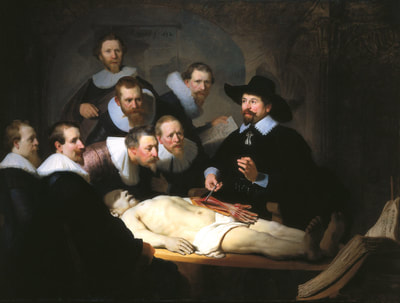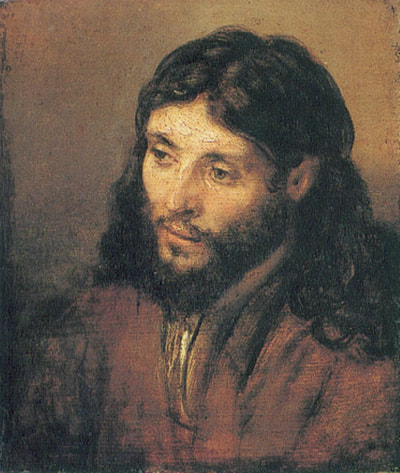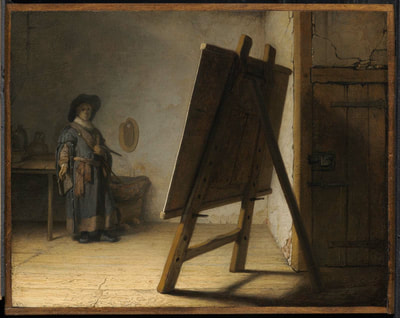Born in Leiden, Netherlands in 1606, Rembrandt Harmenszoon van Rijn attended elementary school from 1612 to 1616 and then attended the Latin School in Leiden, where he partook in biblical studies and lessons on the classics. It is unclear whether Rembrandt completed his studies at the Latin School, but one account claims that he was removed from school early and sent to be trained as a painter at his own request.
From 1620 to either 1624 or 1625, Rembrandt trained as an artist under two masters. His first was painter Jacob van Swanenburgh (1571–1638), with whom he studied for about three years. Under van Swanenburgh, Rembrandt would have learned basic artistic skills. Van Swanenburgh specialized in scenes of hell and the underworld, and his ability to paint fire and the way its light reflects on surrounding objects was likely an influence on Rembrandt’s later work. Rembrandt's second teacher was Amsterdam’s Pieter Lastman (1583–1633), who was a well-known history painter and likely helped Rembrandt master the genre, which included placing figures from biblical, historical and allegorical scenes in complex settings.
In 1625, Rembrandt settled back in Leiden, now a master in his own right, and over the next six years he laid the foundations for his life's work. It was during this time that Lastman's influence was most noticeable, as in several instances Rembrandt deconstructed his former master's compositions and reassembled them into his own, a practice carried on by Rembrandt's own pupils later on. Rembrandt’s paintings created at this time were generally small but rich in detail; religious and allegorical themes were prominent. Rembrandt also worked on his first etchings (1626) in Leiden, and his eventual international fame would rely on the widespread dissemination of these works. Diverging from his contemporaries, Rembrandt endowed his etchings with a painterly quality achieved through suggestive handling of light and dark.
Rembrandt's style soon took an innovative turn involving his use of light. His new style left large areas of his paintings obscured in shadow; through his interpretation, illumination grew rapidly weaker as it extended into the painting, creating spots of brightness and pockets of deep darkness. In this vein, in 1629 Rembrandt completed Judas Repentant and Returning the Pieces of Silver, among others, works that further evidence his interest in the handling of light. Another example is his Peter and Paul Disputing (1628), in which the painting’s lighted elements are clustered together and surrounded by clusters of darker tones, drawing the viewer's eye to a general focal point before moving in to observe the details within. Starting in 1628, Rembrandt took on students, and over the years his fame attracted many young artists seeking to learn at his side. Only an estimate of the number of his pupils can be made, since official registers of trainees have been lost, but it is believed that over the course of his career he had fifty or so students. To continue reading article, please visit biograpy.com/people/rembrandt-9455125 Rembrandt quotes
“Choose only one master - Nature.”
“Painting is the grandchild of nature. It is related to God.” “Without atmosphere a painting is nothing.” “Practice what you know, and it will help to make clear what now you do not know.” “A painting is finished when the artist says it is finished.” “I envy the poet. He is encouraged toward drunkenness and wallows with nubile wenches while the painter must endure wretchedness and pain for his art.” “Life etches itself onto our faces as we grow older, showing our violence, excesses or kindnesses.” “Of course you will say that I ought to be practical and ought to try and paint the way they want me to paint. Well, I will tell you a secret. I have tried and I have tried very hard, but I can't do it. I just can't do it! And that is why I am just a little crazy.” “Try to put well in practice what you already know; and in so doing, you will in good time, discover the hidden things you now inquire about. Practice what you know, and it will help to make clear what now you do not know.” “A painting is complete when it has the shadows of a god.” “I can't paint the way they want me to paint and they know that too” “A work is finished when an artist realizes his intentions.” “Old age is a hindrance to creativity but cannot crush my youthful spirit.” “A painting is not made to be sniffed.” “An honest man always values earning honor over wealth.” “Sincerity is the eventual deception of all great men.”
0 Comments
Leave a Reply. |
How to draw like a Master Artist with Step by Step FREE "Online Art Classes and Tutorials." Subscribe below.
More Artists Coming Soon! Stay CONNECTED.
Famous Artists
All
|













